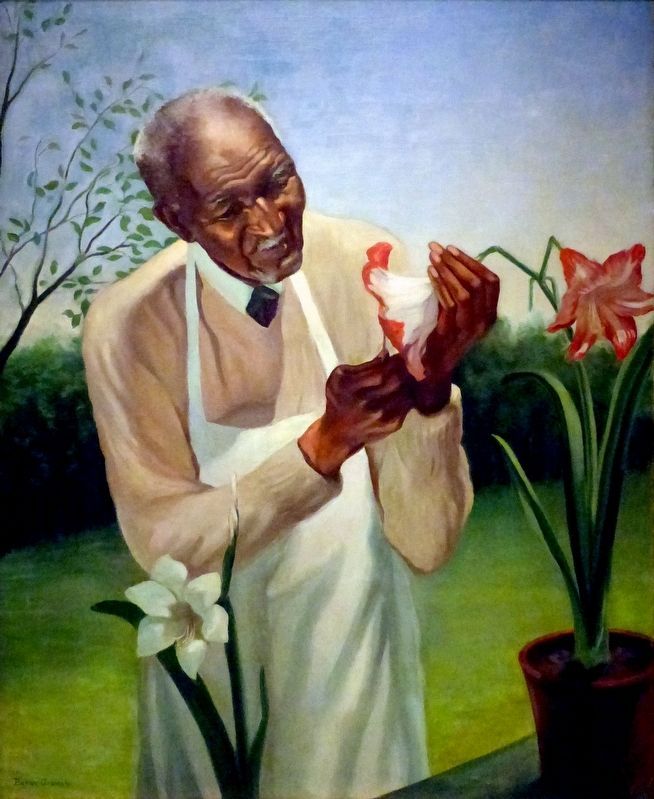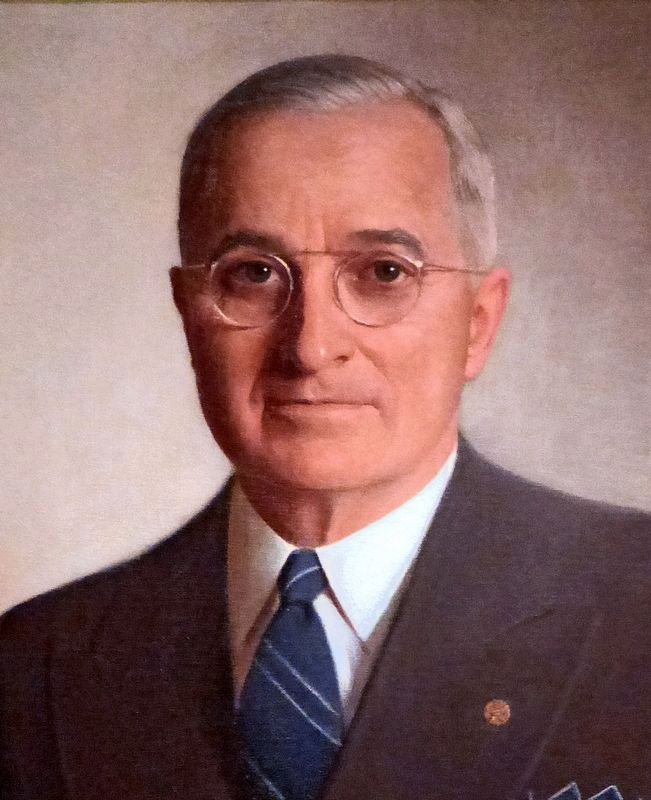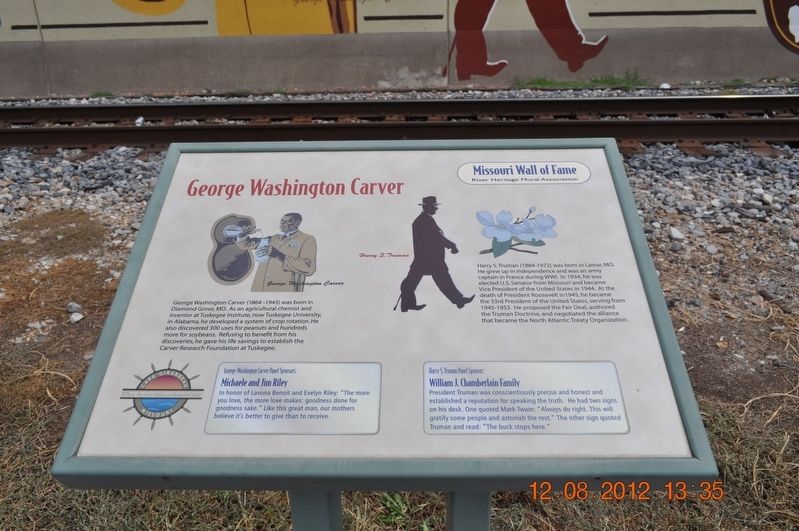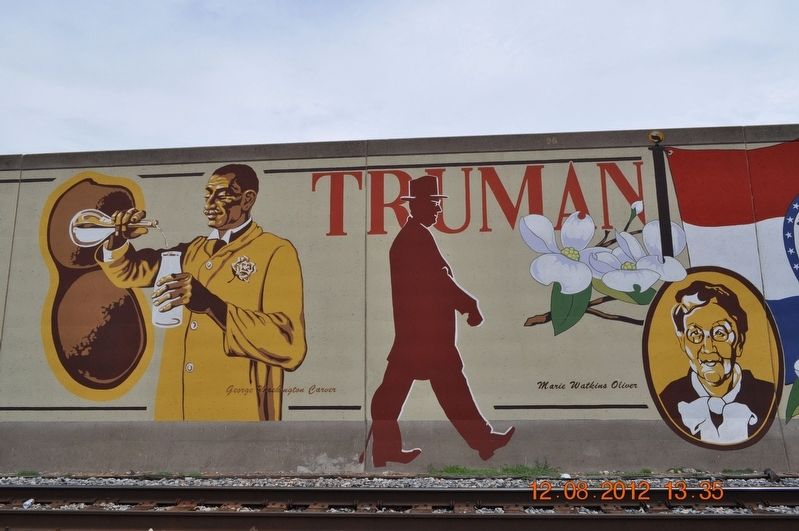Cape Girardeau in Cape Girardeau County, Missouri — The American Midwest (Upper Plains)
George Washington Carver
George Washington Carver (1864-1943) was born in Diamond Grove, MO. As an agricultural chemist and inventor at Tuskegee Institute, now Tuskegee University, in Alabama, he developed a system of crop rotation. He also discovered 300 uses for peanuts and hundreds more for soybeans. Refusing to benefit from his discoveries, he gave his life saving to establish the Carver Research Foundation at Tuskegee.
George Washington Carver Panel Sponsors:
Michael and Jim Riley
In honor of Lavona Benoit and Evelyn Riley: "The more you love, the more love makes: goodness done for goodness sake." Like this great man, our mothers believe it's better to give than to receive.
Harry S. Truman (1884-1972) was born in Lamar, MO. He grew up in Independence and was an army captain in France during WWI. In 1934, he was elected U.S. Senator from Missouri and became Vice President of the United States in 1944. At the death of President Roosevelt in 1945, he became the 33rd President of the United States, serving from 1945-1953. He proposed the Fair Deal, authored the Truman Doctrine, and negotiated the alliance that became the North Atlantic Treaty Organization.
Harry S. Truman Panel Sponsor: William J. Chamberlain Family
President Truman was conscientiously precise and honest and established a reputation for speaking the truth. He had two signs on his desk. One quoted Mark Twain: "Always do right. This will gratify some people and astonish the rest." the other sign quoted Truman and read: "The buck stops here.”
Erected by Missouri Wall of Fame River Heritage Mural Association.
Topics and series. This historical marker is listed in these topic lists: African Americans • Agriculture • Education • War, World I. In addition, it is included in the Former U.S. Presidents: #33 Harry S. Truman, the George Washington Carver, and the Historically Black Colleges and Universities series lists.
Location. 37° 18.138′ N, 89° 31.088′ W. Marker is in Cape Girardeau, Missouri, in Cape Girardeau County. Marker is on Water Street. Located on Missouri Wall of Fame along the Missouri River Front. Touch for map. Marker is in this post office area: Cape Girardeau MO 63701, United States of America. Touch for directions.
Other nearby markers. At least 8 other markers are within walking distance of this marker. 1918-1919 (here, next to this marker); The Civil War / The Boys of Summer / Sports Dazzlers (here, next to this marker); 1980 (a few steps from this marker); Muralist / Broadcasters (a few steps from this marker); 2003 (a few steps from this marker); 1909 (a few steps from this marker); Hollywood (a few steps from this marker); 1916 (within shouting distance of this marker). Touch for a list and map of all markers in Cape Girardeau.
Regarding George Washington Carver. Harry S. Truman was not Vice President in 1944. He was elected to that office in 1944 but did not assume it until Jan. 20, 1945, then succeeded Franklin D. Roosevelt on Apr. 12, 1945.
Also see . . .
1. George Washington Carver. Carver’s research and innovative educational programs were aimed at inducing farmers to replace expensive commodities, and he developed a variety of uses for crops such as cow peas, sweet potatoes and peanuts. Carver had abandoned both teaching and agricultural plot work by the late 1920s, though he continued to advise farmers and students. (Submitted on September 1, 2017, by Sandra Hughes Tidwell of Killen, Alabama, USA.)
2. Harry S. Truman. Truman was born in Lamar, Missouri, and spent most of his youth on his family's 600-acre farm near Independence. In the last months of World War I, he served in combat in France as an artillery officer with his National Guard unit. After the war, he briefly owned a haberdashery

Photographed By Allen C. Browne, August 9, 2015
3. George Washington Carver
This 1942 portrait of George Washington Carver by Betsy Graves Reyneau hangs in the National Portrait Gallery in Washington DC.
“ Born into slavery, George Washington Carver overcame the obstacles of slender means and racial discrimination to seek an education. He believed that ‘when you can do the common things of life in an uncommon way, you will command the attention of the world.” These words, coupled with his lifelong goal to help poor black farmers trapped in sharecropping and dependency on cotton as a crop, pervaded his work at Alabama's Tuskegee Institute, where he was director of agricultural teaching and research for nearly forty years. Carver's laboratory investigations led to the discovery of more than 450 new commercial products-ranging from margarine to library paste -that could be extracted from previously untapped sources such as the peanut and sweet potato. He demonstrated for southern farmers the wisdom of diversifying crops, instead of relying mainly on the soil-exhausting crop of cotton.” — National Portrait Gallery
“ Born into slavery, George Washington Carver overcame the obstacles of slender means and racial discrimination to seek an education. He believed that ‘when you can do the common things of life in an uncommon way, you will command the attention of the world.” These words, coupled with his lifelong goal to help poor black farmers trapped in sharecropping and dependency on cotton as a crop, pervaded his work at Alabama's Tuskegee Institute, where he was director of agricultural teaching and research for nearly forty years. Carver's laboratory investigations led to the discovery of more than 450 new commercial products-ranging from margarine to library paste -that could be extracted from previously untapped sources such as the peanut and sweet potato. He demonstrated for southern farmers the wisdom of diversifying crops, instead of relying mainly on the soil-exhausting crop of cotton.” — National Portrait Gallery
3. Mississippi River Tales Mural. The Mississippi River Tales is a mural containing 24 panels covering nearly 18,000 square feet (1,700 m2) of the 15-foot (4.6 m)-high downtown floodwall in Cape Girardeau, Missouri. It illustrates the history of the area beginning with the Native Americans who inhabited the area between 900 and 1200. Each panel tells a story: Louis Lorimier platting the city in 1793, the transfer of Upper Louisiana from France to the United States in 1804, Missouri gaining statehood in 1821, the coming of the railroad in 1880, the Big Freeze of 1918-19 and the completion of the Bill Emerson Memorial Bridge, among many others. The paintings are in a style similar to that of painter Thomas Hart Benton. (Pamela Selbert, Chicago Tribune, November 18, 2007). The mural was painted by Chicago artist Thomas Melvin,[1]

Photographed By Allen C. Browne, November 29, 2015
4. Harry S. Truman
This 1945 portrait of Harry S. Truman (1884-1972) by Jay Wesley Jacobs hangs in the National Portrait Gallery in Washington, DC.
"This portrait was painted just after Harry Truman became president following Franklin Roosevelt's death on April 12, 1945. It was an unlikely ascension, and in many ways Truman seemed unprepared for the job. He had risen to the Senate owing largely to his ability to get along and go along with Democratic interests. Roosevelt had chosen Truman to replace incumbent Vice President Henry Wallace because he was reliable and middle-of-the-road. On hearing of FOR's death, Truman said that he felt like 'the moon, and the stars and all the planets' had fallen on him, but he resolved to do his best. In the summer of 1945, he faced the daunting task of ending the war in the Pacific and negotiating with an increasingly belligerent Soviet Union. Facing Soviet expansionism, he crafted the Marshall Plan, the strategy that helped rebuild war-torn Europe. In office, Harry Truman demonstrated a pragmatic flexibility that earned him the respect of both his contemporaries and historians." -- National Portrait Gallery
"This portrait was painted just after Harry Truman became president following Franklin Roosevelt's death on April 12, 1945. It was an unlikely ascension, and in many ways Truman seemed unprepared for the job. He had risen to the Senate owing largely to his ability to get along and go along with Democratic interests. Roosevelt had chosen Truman to replace incumbent Vice President Henry Wallace because he was reliable and middle-of-the-road. On hearing of FOR's death, Truman said that he felt like 'the moon, and the stars and all the planets' had fallen on him, but he resolved to do his best. In the summer of 1945, he faced the daunting task of ending the war in the Pacific and negotiating with an increasingly belligerent Soviet Union. Facing Soviet expansionism, he crafted the Marshall Plan, the strategy that helped rebuild war-torn Europe. In office, Harry Truman demonstrated a pragmatic flexibility that earned him the respect of both his contemporaries and historians." -- National Portrait Gallery
Credits. This page was last revised on February 17, 2022. It was originally submitted on September 1, 2017, by Sandra Hughes Tidwell of Killen, Alabama, USA. This page has been viewed 354 times since then and 17 times this year. Last updated on February 17, 2022, by Carl Gordon Moore Jr. of North East, Maryland. Photos: 1, 2. submitted on September 1, 2017, by Sandra Hughes Tidwell of Killen, Alabama, USA. 3. submitted on September 4, 2017, by Allen C. Browne of Silver Spring, Maryland. 4. submitted on September 5, 2017, by Allen C. Browne of Silver Spring, Maryland. • Devry Becker Jones was the editor who published this page.

